Google’s plans for a new high-tech Mountain View campus total over 3.4 million square feet, with a series of canopied structures rising across 60 acres on four North Bayshore sites (the 18-acre Landings; a 7.5 acre parcel on Huff Avenue; a 22-acre block at Charleston and Joaquin; and 12.5 acres south of Charleston at Shoreline Boulevard).
And as designed and envisioned by Bjarke Ingels Group (BIG) and Heatherwick Studio, the interior of the structures would transform on demand, by way of automated cranes and robots.
From the Business Times which had the scoop:
Inside the glass canopies, Google imagines stationary steel support columns upon which lightweight, modular building pieces can be inserted, removed, raised or lowered at will. Think of the floors sort of like oven racks; the walls between them can be added, or not. Crabots (which Google calls “a range of small flexible and manageable cranes and robotic machines”) would lift and move these building segments around almost like furniture.
“We envision there will be some more permanent structures like stairwells and restroom cores and things like that,” said [David] Radcliffe, who is Google’s vice president of real estate and workplace services. “Then we think there will be other components you can actually take out and put in.”
The canopies themselves would generate electricity, while movable shades embedded in a second canopy layer control glare and keep the interior cool.
Google’s North Bayshore campus proposal includes over 30 acres of reclaimed open space as well, with new wetlands, woodlands, burrowing owl habitat, parks and an eleven mile “green loop” for walking and biking throughout the campus, and a pedestrian/bike bridge across Highway 101 at Rengstorff Avenue.
If approved, Google hopes to have its first two structures on the Landings and Huff sites in place by the end of 2020, with the campus complete by 2024.
And if approved, Google’s plans could effectively block LinkedIn’s plans for a North Bayshore expansion, plans which will also be presented to the city of Mountain View today.
UPDATE: Google’s gallery of North Bayshore Campus renderings and pitch in video form:
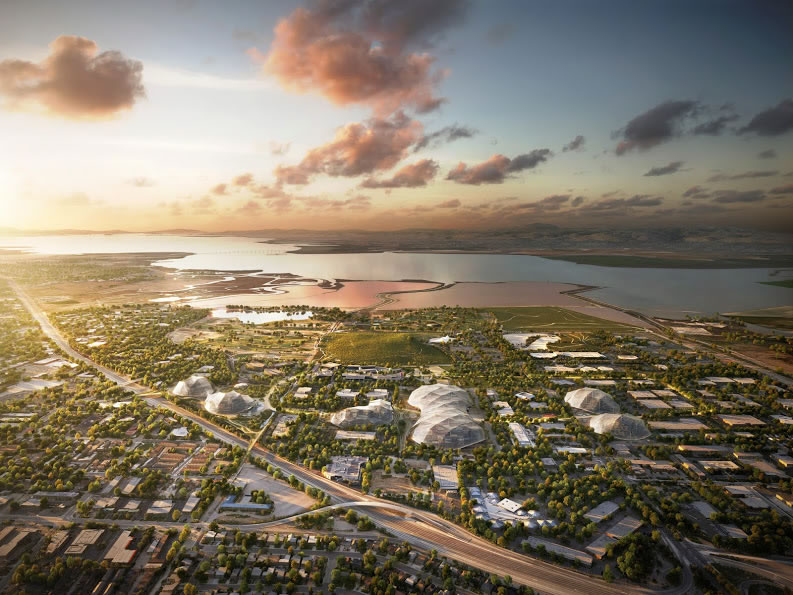
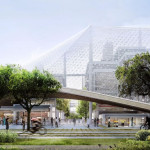
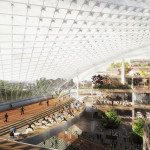
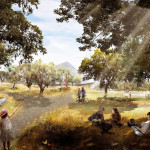
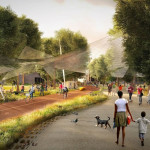
I am a little confused that the two plans SS has shown for the Google complex look completely different.
[Editor’s Note: That’s because they’re two completely different plans and sites. As noted and captioned on our previous piece, the NBBJ design and development was halted two years ago.]
jlasf: They are from two different eras, and two different architecture firms.
What a surprise, the techies, are building a bubble to work in and seal themselves off from the rest of the world. Oh wait, they have already done that.! Wonder where the buses will park.
Except that unlike Apple this campus will be open to the public and will even have retail.
Yeah just like my job did. They built a building to put their employees in it. God we are horrible. I did myself, rented an apartment so I could seal myself off from the world.
What a surprise, vicious luddite imagines a reality to fit personal prejudices without examining the facts laid before him. It might serve what remains of your credibility to watch the 10 min video attached to this article before vilifying its creators.
Did see the video. Just like the Apple building, a large expensive, monument, I do not see it as a positive addition to Mountain View or that it will create a a quality environment In which to work or if the building will even function. Just the sound control alone seems daunting, especially when they will be reconstructing all those spaces. computer generated architecture, how about use people.
Considering this site is moderated, one has to wonder why comments like this from “Fraser” are not removed. Thoroughly negative, adds no value or insight whatsoever, and basically just reeks of despair.
[Editor’s Note: While it is our policy to moderate comments which are off-topic, belligerent, offensive or nothing more than a personal attack, we have never removed a comment for voicing an opinion with which we, or other readers, might simply disagree.]
“… the interior of the structures would transform on demand, by way of automated cranes and robots.”
“Inside the glass canopies, Google imagines stationary steel support columns upon which lightweight, modular building pieces can be inserted, removed, raised or lowered at will. Think of the floors sort of like oven racks; the walls between them can be added, or not.”
Um…. yeah…. so will you be applying for and acquiring a building permit each time a piece changes? Make sure you pass inspection and get your CO each time as well, otherwise you are breaking the law.
This is an obvious example of when a law should change because it’s hampering innovation. Modular construction and movable automated construction is a field that should be explored and not bogged down by stuff like that.
In part I agree with you, but one has to consider the impact to life safety, egress, accessibility, fire sprinkler coverage and a litany of other facets that affect the health, safety and welfare of the occupants. There is a reason that changes in built environments are engineered by professionals. California’s building code is based upon the IBC. Getting that to change is going to be extremely challenging.
I’m sure they’ll figure it out… we have movable partitions where the egress for both closed and open are considered… This will be more complex, but same principle.
Sort of like the game Jenga? But in real life?
Google’s 10 minute video discussing the proposal.
Millions of square feet of commercial space and almost zero discussion of housing beyond an almost footnote of a reference. At what point does San Francisco just sue these suburban jurisdictions to get their act in gear and bear some of the area’s housing need load?
First off, San Francisco has a much higher jobs to housing ratio than the South Bay, so get your facts straight. Second, Google is aggressively trying to build housing as part of these plans and the only bottleneck is the city of Mountain View.
I see a jogger and someone on a bike (because both are apparently cool), but any sense of public transit nearby?
Always happy to have new Google employees in SF. They are smart, educated, increase the tax base and don’t suck up city service money. Having a more educated city is better for everyone and should be an incentive to young kids to work harder. That’s good for innovation and our country
Wasn’t Archigram’s Plug-In City the last iteration of this idea?
Completion date of 2024, isn’t this around the date that Ray Kurzweil predicts as the arrival of Singularity? No small note in the Google grand plan. Love this plan about a million times more than the previous SS post.
Alas a truly visionary concept for workspace in our corner of the world. Apple’s vision was such a disappointment.
I feel for the town of Mountain View and understand why many of its residents are fighting to maintain their way of life. But the genie is out of the bottle, it has become a company town.
If the new city council is smart, they will cater to [Google’s] needs/wants/desires while extracting every last penny they possibly can, unlike the politicians and leaders in San Francisco that are worthless at negotiating and give away the store, time after time.
Anybody understand how a glass canopy could let light through but also generate significant electricity?
It is probably a semi-translucent solar array. Even some of the panels you can buy today let light through. The solar cells are attached to a translucent substrate (plastic? fiberglass?) and sunlight passes through where the solar cells don’t cover.
The canopy appears to be a giant rain and wind fly over the buildings, which themselves seem to have open exterior walls, though those may just be exterior terraces. Looks like it could be cold at night. Would make sense to try this on a few smaller buildings for some years to gauge the effectiveness, maintenance issues/costs, etc. At least it would give them a ready framework for mosquito netting to protect against west nile.
Very interesting. I’d have liked to see high density housing included in Googleville. I am not sure how you can really create a neighborhood otherwise. I guess the main transit improvement is a pedestrian bridge over 101 but otherwise it’s Google buses forever
The proposal also has a bikelane on the bridge over 101, but yes I agree. Their ideal as explained in the video sounds like a college campus in a college town/small city. They are actually expanding a large office park near the center of a technopole/metropolitan area.
Go back and read the 80’s book EDGE CITY, which devotes a huge portion to the San Francisco Bay Area and has forecasted almost everything that has taken place. The book claimed that the job and housing growth would shift to the South Bay and East Bay and San Francisco would become an “adult Disneyland”. So much for all the non-fact provided theories posted by some that the future is in high density neighborhoods where bikes will be the mode of transit. All of these new low density corporate campus headquarters show where the real lifestyle choices are still being made for our region. What we have become is a “boutique housing” community mostly for people who are creating wealth outside the city. While many of the higher executives of these companies may have homes or condos up here, they also have residences down in Palo Alto, Menlo Park, Atherton, Woodside, etc. So while we are lectured by some that the “success” of San Francisco is that you can enjoy a “car free” lifestyle”, the vast majority of the Bay Area is increasingly living and working in sprawling areas no different than any other American urban region. Could it be, that despite the howls from some city living is the future, the real Bay Area residents are anti-urban? They live in a sprawl with far less density than the Los Angeles region, they use cars more than many American metro areas, they sit in traffic LONGER than any other metro region (Atlantic Cities had an article about how Bay Area workers drive longer distances to work and spend longer periods in traffic than any other region), and they visit the urban core (San Francisco) less frequently than suburban residents of Chicago, Boston, Seattle, San Diego, etc.
SF has tons of job growth though and a much higher daytime population
I would have to disagree with you. Any walkable older part of many suburbs around the area are priced at a premium. Many more people desire this type of housing than we allow to be build.
@Zig…all closer in suburbs are definitely higher in value, but Menlo Park, Palo Alto, Woodside, Portola, Saratoga, are as expensive as many parts of San Francisco, as this site has shown with some recent sales in Palo Alto as an example, and they are not close to “the city”. I think the point is that the Bay Area has far more in common with an Atlanta or other sprawling region than a New York or Chicago where jobs are concentrated in a downtown central area. My argument is not against density, using bikes, or walkable neighborhoods. My argument is with people who refuse to admit that the economic engine that created this boom we are all enjoying, was not initiated or concentrated in within the San Francisco city limits. We are a part of the Bay Area region, but without all the prosperity that was created down south, this city would still just be a dirty tourist oriented destination. On second thought….it still is.
Mountain View isn’t yet ready to revise zoning for more housing in that part of Google’s been trying to bend that for years. town. Last year’s city council as vehemently against the idea; this one seems less knee-jerk.
I think the long-term plays for nearby housing would be later plans on Moffett, or maybe next to the nearby trailer park [namelink]. But that housing wasn’t part of this RFP has more to do with the city’s proposal process.
Buses driven by card carrying members of the Teamsters union, most likely. And ridden by workers recently freed to take jobs from competitors if they don’t like the commute or working in tent-city (High-Tech Employee Antitrust Litigation, 11-cv-2509). Sometimes ‘trickle down’ flows better with a few lawsuits and union votes.
Interesting concept, reminds me a bit of the airport in Bangkok. But wonder about some practical issues:
1- heating all that air space under the canopies.
2- keeping canopies clean. Glass looks great when clean. Dirty, streaky, stained glass looks like crap.
3- parking. Where do all the cars go (underground? Good but muy expensivo.)
Everyone will be riding driverless cars by then at Google
“Despite tens of billions of dollars in government subsidies and countless incentives, the percentage of Bay Area commuters taking mass transit hasn’t gone up a bit in more than two decades — in fact, it’s declined.
A new study by the Metropolitan Transportation Commission found that while ridership has hit record numbers on BART and Caltrain as the Bay Area’s population has grown, per capita usage of transit has dropped 14 percent since 1991. (SF Chronicle – linked with my name)
I could not agree more about driverless cars, and personal transportation vehicles being a part of our future. We can hope everyone will ride bikes or use an extensive transit system yet to be built, but the numbers show people are driving more, not less, and office campuses like this new Googleplex are created partially because they are car convenient. I am not saying this is desirable, but just pointing out the fiction that “cars are a thing of the past”.
Despite tens of billions in government subsidies and countless incentives, the percentage of Bay Area commuters driving alone to work has decreased, making us wonder why we continue to massively subsidize the private automobile and don’t instead invest more in modes that have shown massive growth – walking, cycling, working at home.
Why wasn’t this the starter to that article? The stats they show bear this out more than what they lead with.
Hi anon, care to site a source that differs with the article that claims per capita usage of transit has dropped by 14 percent? OR are you only talking about San Francisco proper, which is roughly 11% of the Bay Area population?
According to MTC’s new website (namelink): “The average [Bay Area] resident boarded transit 79 times per year in 1991, while in 2012, this had fallen to 68 trips per year – a decline of 14 percent over the two decades.”
The new website has data and graphics by year, county, mode, totals and per capita. During this 20+ year time, BART and Caltrain are up and all other transit operators down. The main replacement is work from home, for which the enabler is the Internet. Fiber to the home in urban areas is a less expensive way to reduce commuting than any proposed transit project.
I said nothing about transit not dropping – it certainly has. My point was that driving has also dropped, which is why we should be focusing more money on pedestrian and cycling improvements, since those are the two modes that have substantially increased. Especially if you include working from home (which includes me). I’d love for a few million to be tossed at fixing the atrocious sidewalks in my neighborhood, for example.
@anon, bike and walk haven’t increased much in the Bay Area as a percentage of the commute to work over the timeframe being discussed here (20+ years). They have increased significantly in some small geographies, but not much Bay Area wide and not much when measured by the actual number of additional people walking and cycling to work.
What has grown steadily and is well on the way to eclipsing both of them is work from home. Cheaper to move bits than bodies. Cheaper with more upside potential to pull/trench fiber than pave roads, tunnel subways, or configure BRTs. Also saves time. The average Bay Area commute is over 30 minutes each way. That’s more than 200 hours of lost time per year per person.
In 1980 the number of people that walked or biked to work in the Bay Area was about 140k. Now it is about 175k. In the same time the number of people that worked from home grew from 47k to about 185k. That’s a 25% increase for walk+bike vs a four-fold increase for telecommute.
Here are the commute to work shares for the Bay Area from 1980 to 2012 for bike, walk, and work from home:
Year, Bike, Walk, Work-from-home
1980 1.3% 4.4% 1.9%
1990 1.1% 3.6% 3.4%
2000 1.1% 3.2% 4.0%
2012 1.4% 3.6% 5.7%
I agree with all of that Jake. My point was simply that if we’re seeing explosive growth in other modes, we should spend money there. Someone working from home is going to make more use of sidewalks to walk to restaurants for lunch, shops for work items, etc, so it makes sense to spend more on pedestrian improvements if that mode is exploding (in addition to adding more fiber).
Well of course. Public transit only works to bring people to the CBD for the most part. The fact that we waste money on useless PT like light rail in Santa Clara Valley is a political problem
Yes the VTA light rail routing was driven more by political expediency than transportation efficiency. Funneling all traffic through a slow downtown bottleneck appeased the SJ downtown RDA. That crazy zigzag path from north SJ to Mt.View follows the path of least resistance money and NIMBY-wise but produced a slow commute. It takes an hour to go from Mt.View to downtown SJ, almost the same speed as bicycling between those two endpoints.
Until the influence of politics and NIMBYs can be reduced, transit projects will continued to be handicapped.
I believe VTA light rail is the most inefficient system in the world by most measures
VMT has peaked in the US. Transit use follows land use so it really is a choice how we order things. Randomly adding mass transit fails
Reminds me of the Moshe Safdie buildings at Expo 67 in Montreal. They were modular units can could be placed in a variety of ways.
Thank you for that fascinating post!
ok this is not architecture but a political ploy. If not, please let me know how one dissipates all the heat into the glass sky, and would like to hear about the microclimate created by the structures, so what happens when a 50 mph gust blows through all the openings. Around all those levels. This a great undergraduate design concept. But nothing more.
This is certainly architecture, though ahead of engineering. Probably should think of the canopy as active, with embedded sensors, processors, and mechanics/actuators built in. I would expect every one of them will have an IP address on a private network. Google pretty much reinvented massive scale computing. Their data centers handle much more difficult thermal conditions. And they could easily monitor the environment/weather/sun to make thousands of fine adjustments per second. FWIW, Mt View’s wind profile is fairly trivial to manage.
I wonder more about those tall posts moving during an earthquake to cause constructive interference in the net. Perhaps it will have a failsafe/earthquake mode, something that relaxes the net enough to tolerate poles swinging.
One hint from the biz journal article:
The canopies themselves would generate electricity, while movable shades embedded in a second canopy layer control glare and keep the interior cool.
If it sounds futuristic, that’s because it is. Much of the technology doesn’t exist yet, Radcliffe said. “This is new ground,” he said. “We have some of the best engineers and minds in the world working on it.”
Great thought, but futuristic is a concept not reality. So when do we start to build it? Next. Plus after having my own architectural practice for 40 years, there is a balance between concept, business, and economic reality. This is not it.
I take it then you weren’t on their short list, or perhaps even their long list.
Google’s entire business is built on turning futuristic concepts into commonplace realities. Some have worked out great and changed the world, some are works-in-progress, some have been a bust, some never even got built.
Their economic reality is they have more than enough money to do this if they want, $64 billion in cash and short term investments. Only a few people there need to agree to make it happen.
The canopy is eye catching, but making re-configurable buildings seems more daunting, as others have mentioned above. I just wish they would figure out how 19,000 employees could work effectively without all being in the same place. That seems the real failure of creation in these corporate villages, whether this one or Apple HQ, or Facebook, or ….
I can already imagine the glorious concrete ruins in 20 years or so after they realized the canopies leaked, the modular construction was unstable, and Larry Page made the snap decision that he would rather have a gigantic skyscraper.
Interestingly, Google seems to not be the only tech company considering new digs in Mountain View, but without any obvious plan for mass transit support. I just read in the SJ Mercury that LinkedIn wants more space and filed plans the day Google announced the new campus for their own campus located nearby Google on the property wedged in between 101 and the bay. But apparently if Google gets what they want from Mountain View, it throws LinkedIn’s plans into question, since they apparently are targeting some of the same currently open property in this location.
In addition, Microsoft just down the highway (and without any major mass transit support either) is redoing their campus and building a multi-story parking garage so that they can convert current surface parking into more office space.
I think about how these companies could have tackled the more space issue while also at least attempting to provide better mass transit support to their employees. I look at Sunnyvale and the city’s efforts to build up right next to the Sunnyvale CalTrain station. There’s a lot of square footage there, but it looks like nobody such as Google, LinkedIn or Microsoft are interested in mass transit. The only “big name” tech company I know of who jumped on the opportunity for supporting a mass transit option in addition to autos and buses was Nokia – a European company who, from what I heard, understood the benefits of supplying mass transit as an option to their employees and was drawn to property there for that reason (among others). Sad.
[Editor’s Note: Or as we originally reported above, “And if approved, Google’s plans could effectively block LinkedIn’s plans for a North Bayshore expansion, plans which will also be presented to the city of Mountain View today.”]
The upzoning near Sunnyvale Caltrain is a great idea but in the grand scheme there really isn’t much space to build on there. Once the Hendy Iron Works closes down that site has possibilities for redevelopment and might create a substantial higher density core to Sunnyvale.
I love that there is a bike in every rendering.
Such an interesting idea. The ability to change the structure would be pretty amazing. But, I’m wondering why the company would choose to work against the Inevitable rising tide of enlightened urbanism
Referring to anything in Mountain View as “urban” still makes me giggle.
Also, aren’t all great ideas really only inevitable in hindsight?
Too bad Google’s not coming to MIssion Bay instead of the stinkin’ Warriors. :/
The Warriors coming to Mission Bay will be fantastic, actually.
UPDATE: Google’s High-Tech Campus And Expansion Plans Cut Short